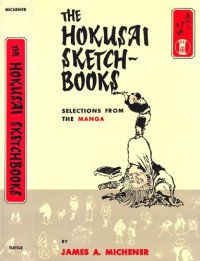
James Michener, well known for his historical fiction, was also an aficionado of Japanese culture and art, marrying, as he did, a Japanese woman after WWII, when such unions were controversial. Part of his attraction to the woman was a fascination with her culture, and he became a lover of Japanese imagery and collector of Japanese art.
This book offers a collection of artwork that Michener considers most significant from the Hokusai Manga, 15 volumes of woodblock prints from sketches, marketed to the largely illiterate masses of Japan for their entertainment. The word Manga can be translated as “random sketches,” “cartoons,” or “drawings from life.” Manga are a literary form still produced today. The book’s margins are filled with sketches, in addition to the full-page plates. Michener’s commentary on the art includes considerable biographical detail of this eccentric artist who lived in over 90 houses and assumed over 50 names.
The commentary is interesting partly because it is historical in itself, written in 1958. Many of the subjects—such as women wearing tall rain zoris with removable toe coverings—that Michener says can “still be seen today” have disappeared from Japan during the past 60 years. Another historical aspect is that the book is bound as the Manga was, in pages that are folded in and stitched so that each page is doubled, a process no publisher would seriously consider today.
Michener starts out with a summary of each of the 15 volumes, then organizes Hokusai’s subjects by chapter: people, flora, fauna, landscape, the past, grotesqueries, technical, architecture, and forerunners, the latter category being images that Hokusai uses later in his more famous and refined artwork. Michener has distinct likes and dislikes, however, he does not present just his favorites, but compiles sketches that have cultural and artistic significance. He shows samples of both beautiful renderings, and those that miss their mark.
Michener is quick to point out cultural context for Hokusai’s art. Although Michener gives personal opinions, he also states how Hokusai’s contemporaries, for whom the Manga was designed, were better able to appreciate, for example, images of ghosts and ancient mythology. He likens Hokusai to Leonardo da Vinci, similarly imagining and illustrating new technologies, but in the limiting context of late feudal Japan, akin to European Medieval society. Hokusai’s curiosity about the world was unusual in his era. In fact, some of his activities, like reading Western books, were illegal. Both his sense of life and sense of humor are reflected in his art.
Michener’s portrait of this unusual man is an interesting read, but the best way to read this book is: read Michener’s introduction on the Manga, then look at the art and develop your own impressions of it. Then go back and read the text. Then, look at the art again.
This book offers a collection of artwork that Michener considers most significant from the Hokusai Manga, 15 volumes of woodblock prints from sketches, marketed to the largely illiterate masses of Japan for their entertainment. The word Manga can be translated as “random sketches,” “cartoons,” or “drawings from life.” Manga are a literary form still produced today. The book’s margins are filled with sketches, in addition to the full-page plates. Michener’s commentary on the art includes considerable biographical detail of this eccentric artist who lived in over 90 houses and assumed over 50 names.
The commentary is interesting partly because it is historical in itself, written in 1958. Many of the subjects—such as women wearing tall rain zoris with removable toe coverings—that Michener says can “still be seen today” have disappeared from Japan during the past 60 years. Another historical aspect is that the book is bound as the Manga was, in pages that are folded in and stitched so that each page is doubled, a process no publisher would seriously consider today.
Michener starts out with a summary of each of the 15 volumes, then organizes Hokusai’s subjects by chapter: people, flora, fauna, landscape, the past, grotesqueries, technical, architecture, and forerunners, the latter category being images that Hokusai uses later in his more famous and refined artwork. Michener has distinct likes and dislikes, however, he does not present just his favorites, but compiles sketches that have cultural and artistic significance. He shows samples of both beautiful renderings, and those that miss their mark.
Michener is quick to point out cultural context for Hokusai’s art. Although Michener gives personal opinions, he also states how Hokusai’s contemporaries, for whom the Manga was designed, were better able to appreciate, for example, images of ghosts and ancient mythology. He likens Hokusai to Leonardo da Vinci, similarly imagining and illustrating new technologies, but in the limiting context of late feudal Japan, akin to European Medieval society. Hokusai’s curiosity about the world was unusual in his era. In fact, some of his activities, like reading Western books, were illegal. Both his sense of life and sense of humor are reflected in his art.
Michener’s portrait of this unusual man is an interesting read, but the best way to read this book is: read Michener’s introduction on the Manga, then look at the art and develop your own impressions of it. Then go back and read the text. Then, look at the art again.
Download the book The Hokusai Sketchbooks for free or read online
Continue reading on any device:

Last viewed books
Related books
{related-news}
Comments (0)